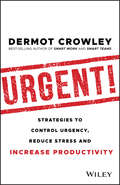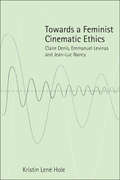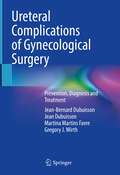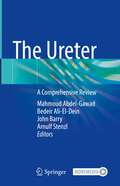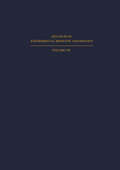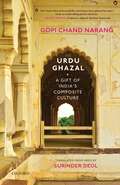- Table View
- List View
Urgent!: Strategies to Control Urgency, Reduce Stress and Increase Productivity
by Dermot CrowleyLeverage the power of urgency to avoid burnout and increase performance Urgency—that frantic feeling that we need to be doing more, and faster—is a destructive force in today’s workplace. Unnecessary urgency can be toxic, causing stress and burnout. But not all urgency is bad, and sometimes we really do need to get things done quickly. Too little urgency can lead to inaction and lost productivity. So how do we find the right balance where we can use urgency as a meaningful tool to keep productivity up, without generating burnout? Urgent! is a guide to using urgency for good to help achieve your goals, to drive success, and minimise stress for yourself, your teams, and your business. This book will teach you to moderate urgency for yourself and those you lead. In our age of fast-paced technology, it’s easy to swing between extremes, working reactively one minute, and being inactive the next. The middle ground, described in this book, allows us to work in the “Active Zone” where we maximise proactivity and productivity. By following the practical strategies outlined in this book, readers will learn to understand urgency, become proactive rather than reactive, and lead teams to their fullest potential. • Eliminate stress and burnout for yourself, your teams, and your businesses • Learn how to dial urgency up or down, depending on the situation • Keep teams working in the optimal productive zone by moderating urgency • Stay focused on what's important and learn prioritisation skills to avoid burnout If you feel that you and your team are caught up in busy work, stressed to the max by competing demands, leaving no room to focus on what really matters, Urgent! will show you a new way of thinking, leading, and responding. Learn the skills to reduce overload, get more done, and achieve better performance each day.
Urgent!: Strategies to Control Urgency, Reduce Stress and Increase Productivity
by Dermot CrowleyLeverage the power of urgency to avoid burnout and increase performance Urgency—that frantic feeling that we need to be doing more, and faster—is a destructive force in today’s workplace. Unnecessary urgency can be toxic, causing stress and burnout. But not all urgency is bad, and sometimes we really do need to get things done quickly. Too little urgency can lead to inaction and lost productivity. So how do we find the right balance where we can use urgency as a meaningful tool to keep productivity up, without generating burnout? Urgent! is a guide to using urgency for good to help achieve your goals, to drive success, and minimise stress for yourself, your teams, and your business. This book will teach you to moderate urgency for yourself and those you lead. In our age of fast-paced technology, it’s easy to swing between extremes, working reactively one minute, and being inactive the next. The middle ground, described in this book, allows us to work in the “Active Zone” where we maximise proactivity and productivity. By following the practical strategies outlined in this book, readers will learn to understand urgency, become proactive rather than reactive, and lead teams to their fullest potential. • Eliminate stress and burnout for yourself, your teams, and your businesses • Learn how to dial urgency up or down, depending on the situation • Keep teams working in the optimal productive zone by moderating urgency • Stay focused on what's important and learn prioritisation skills to avoid burnout If you feel that you and your team are caught up in busy work, stressed to the max by competing demands, leaving no room to focus on what really matters, Urgent! will show you a new way of thinking, leading, and responding. Learn the skills to reduce overload, get more done, and achieve better performance each day.
Urgency and Human Rights: The Protective Potential and Legitimacy of Interim Measures
by Eva Rieter Karin ZwaanThis book deals with urgency and human rights. ‘Urgent’ is a word often used, in very different contexts. Yet together with a reference to human rights violations, it likely triggers images of people caught up in armed conflict, facing terror from either the state, gangs, paramilitaries, or terrorists. Or of people fleeing terror and facing walls, fences or seas, at risk of being returned to terror, or ignored, neglected, abused, deprived of access to justice and basic facilities, facing death, torture and cruel treatment. Here these both ongoing and expected violations are explored in the context of (quasi-)judicial proceedings as international tribunals and domestic courts are increasingly called upon to order interim measures or accelerate proceedings in such cases. This edited volume concerns the protective potential of interim measures in international human rights cases and the legitimacy of their use and discusses obstacles to their persuasive use, to clarify how their legitimacy and protective potential could be enhanced in the context of concrete legal cases. Examining this is especially pressing when courts and (quasi-)judicial bodies have used interim measures in response to requests by individuals and organisations in the context of issues that are unpopular with governments and/or controversial within society, which has led states to at times employ political pressure to limit their use. Urgency and human rights are discussed from the vantage point of various practitioners and scholars, with the aim of identifying how interim measures could be legitimate and protective and to single out obstacles to their implementation. Drawing from practices developed in various international and regional adjudicatory systems, the contributors provide their perspectives on the legitimacy and/or the protective potential of interim measures and other (quasi-)judicial proceedings in urgent human rights cases. There is considerable discussion about how interim measures can be legitimate and well-functioning tools to address urgent human rights cases. This book aims to contribute to the ongoing discussion in this respect. Dr. Eva Rieter is senior researcher and lecturer public international law and human rights law at the Centre for State and Law, Radboud University, Nijmegen, The Netherlands. Dr. Karin Zwaan is associate professor in the Department of Migration Law at the Centre for State and Law, Radboud University, Nijmegen, The Netherlands.
Urge to Kill: Darker Than Night; In For The Kill; Night Kills; Urge To Kill; Mister X (Frank Quinn #Book 4)
by John LutzFor a killer, once is never enough… Homicide detective Frank Quinn can't stay retired when a new breed of murdering madman is on the prowl. In a city terrorized by bloody brutality, Quinn and his team hunt a psychopath who lures beautiful women into a night of unbridled passion, then wakes them to a vicious, drawn-out death. Stumbling over a trail of horribly defiled bodies, Quinn can't seem to catch up to the killer--because the killer is about to catch up to him. . .Praise for John Lutz:'Lutz offers up a heart pounding roller coaster of a ride.' Jeffrey Deaver.'Lutz knows how to make you shiver.' Harlan Coban
The Urewera Notebook by Katherine Mansfield
by Katherine Mansfield Anna PlumridgeAn authoritative scholarly edition of Mansfield’s camping journal, offering new understandings of her colonial life Katherine Mansfield filled the first half of the Urewera Notebook during a 1907 camping tour of the central North Island, shortly before she left New Zealand forever. Her camping notes offer a rare insight into her attitude to her country of birth, not in retrospective fiction but as a nineteen year old still living in the colony. This publication is theirst scholarly edition of the Urewera Notebook, providing an original transcription, a collation of the alternative readings and textual criticism of prior editors, and new information about the politics, people and places Mansfield encountered on her journey. As a whole, this edition challenges the debate that has focused on Mansfield’s happiness or dissatisfaction throughout her last year in New Zealand to reveal a young writer closely observing aspects of a country hitherto beyond her experience and forming a complex critique of her colonial homeland. Key Features: A new, more accurate transcription of the notebook Textual notes provide significant variant readings from other extant editions of the notebook An introductory essay draws on important new developments in New Zealand literary criticism, advances in historiography of the period and legal history Includes a route map, revised itinerary and authoritative annotation for the text Includes 20 photographs, many previously unpublished, from Beauchamp family photograph albums at the Alexander Turnbull Library and Ebbett Papers at the Hawke’s Bay Museum
Urethral Reconstructive Surgery (Current Clinical Urology)
by Steven B. BrandesUrethral injury may be of secondary importance when the patient comes into the emergency room, but devastating urological complications, such as sexual dysfunction, incontinence, and stricture, may drastically impair quality of life in the long term. This book provides a comprehensive review of adult urethral reconstructive surgery. It evaluates complex urethral problems and includes practical aspects of wound healing and applicable plastic surgical techniques.
Ureteroscopy: Indications, Instrumentation & Technique (Current Clinical Urology)
by Manoj MongaUreteroscopy: Indications, Instrumentation & Technique provides a comprehensive and state-of-the-art review of ureteroscopy and will serve as a valuable resource for urologists throughout the world. The volume provides evidence based outcomes to support the expanding indications for ureteroscopy as well as a strong emphasis on appropriate patient selection. The book also provides detailed recommendations for the step-by-step approach to ureteroscopy from both an instrumentation and techniques perspective. The work is extensively illustrated with endoscopic images and accompanied by a web site of video clips which further highlight the clinical application of available endoscopic techniques. The text also includes highly practical presentations of complex endourologic case presentations with expert analysis and editorial commentary. Example cases would include common but challenging cases of ureteroscopy for transitional cell cancer, horseshoe kidneys, hutch diverticulum, and pregnancy. Ureteroscopy: Indications, Instrumentation & Technique provides a unique and valuable resource in the field of ureteroscopy and will include basic instructions for those currently in training or those who have yet to adapt intrarenal ureteroscopy into their surgical armamentarium. Advanced ureteroscopic approaches are also covered for those wishing to enrich their current clinical expertise.
Ureteroscopy: A Comprehensive Contemporary Guide
by Bradley F. Schwartz John D. DenstedtThis text provides a comprehensive and contemporary discussion of current indications, techniques, technology, and results in ureteroscopy from the world leaders who perform this procedure. It provides not only the latest literature and data regarding URS but also tips and tricks for the reader when performing various URS procedures. Historical prospective will link the reader with the past and provide insight as to why we have evolved into a minimally invasive specialty. Technological advancements of both flexible and rigid ureteroscopic procedures are included to provide the reader with many practical considerations when choosing this modality for their patients. Renowned experts in the field discuss the myriad of supplemental devices that accompany URS and how best to utilize them in one’s practice. Unique to this predominantly clinical text, are sections on simulation and the socioeconomics of URS that demonstrate how the student can learn and acquire techniques and skills of their own. Ureteroscopy: A Comprehensive Contemporary Guide provides its readers with a thorough and complete representation of the current state of URS and its applications and guide those interested in improving their techniques, armamentarium and horizons in this ever-changing world of minimally invasive urology.
Ureteric Stenting
by Ravi KulkarniThe only book dedicated to this important area of urology, Ureteric Stenting comprehensively reviews the entire topic, providing highly specialized advice to enable outstanding clinical management of patients. All aspects of ureteric stenting are covered, from basic to complex, giving urologists, nephrologists and trainees an authoritative and up-to-date guide on best clinical practice.
Ureteric Stenting
by Ravi KulkarniThe only book dedicated to this important area of urology, Ureteric Stenting comprehensively reviews the entire topic, providing highly specialized advice to enable outstanding clinical management of patients. All aspects of ureteric stenting are covered, from basic to complex, giving urologists, nephrologists and trainees an authoritative and up-to-date guide on best clinical practice.
Ureteral Stone Management: A Practical Approach
by Sutchin R. Patel Stephen Y. NakadaWith the rising incidence of urolithiasis, the management of ureteral stones continues to become a larger component of urologic practice. Though almost all urologists deal with ureteral stones, there have been many recent improvements in instrumentation and adjunctive equipment as well as improvements in imaging and the data we can obtain from radiologic imaging in order to guide stone management. Newer topics such as how to limit radiation exposure to both the patient and the urologist, the accuracy and limitations of low-dose computed tomography as well as a review of the most recent studies will be covered in this book. The purpose of this book is to provide a complete updated roadmap to treating ureteral stones, from early management decisions from information found on radiologic studies to adjusting to intra-operative challenges.
Ureteral Complications of Gynecological Surgery: Prevention, Diagnosis and Treatment
by Jean-Bernard Dubuisson Jean Dubuisson Martina Martins Favre Gregory J. WirthThis pictorial book focuses on ureter for gynaecologists. It is written by a multidisciplinary team of experts who share its experience on the study of the ureter in women, with specific attention to the injuries occurring during gynaecological surgery.Supported by a rich iconography, the authors evaluate the causes of injuries of the ureter, discuss their prevention, precise the diagnosis with the support of urological radiology. The urological management of the injury and its consequences are described in the last chapter, with many photos of laparoscopy included.This book is intended for gynaecologists, for all the surgeons specialized in the female pelvis, urologists, oncologists, general surgeons. It is also especially written for fellows, residents, and interns in University Hospitals with a limited experience of surgery of the pelvis.
The Ureter: A Comprehensive Review
by Mahmoud Abdel-Gawad Bedeir Ali-El-Dein John Barry Arnulf StenzlThis book provides a contemporary panorama of advanced knowledge on the ureter. It covers basic knowledge and recent advances in a range of well-organized topics such as stone diagnosis, treatment, ureteroscopy, laser technology, reconstruction, oncology, trauma, embryology and radiology of the ureter. As shown in the table of contents, the book is written by a group of urology and non-urologic experts in their field and is enriched with many illustrations and summary tables. The 26 chapters are each dedicated to specific topics related to ureteral pathology and abnormality as well as diagnostic steps and treatment. Rare diseases that may affect the ureter are also included. Additionally there are basic educational materials that will be suitable for teaching, tutorials as well as electronic supplementary video clips and powerpoint presentations for demonstrations. The future perspectives of ureteral diseases, endoscopic and laparoscopic handling are covered. Fellows and medical professionals will find this a useful book with up-to-date knowledge of the various diseases and to demonstrate specific recent techniques involving stones, strictures and other pathologies of the ureter. Additional questions via app: Download the Springer Nature Flashcards app for free and use exclusive additional material to test your knowledge.
The Ureter
by HarryBergmanThis volume, focusing on the ureter and the diseases which involve it, is an updated second edition. Many journals and textbooks deal with the physiology, pathology, diagnosis, and therapy of derangements of the urinary tract. In most instances, however, the discussion properly centers on the disease process itself and its primary aspects, with only a tan gential description of effects on the ureter. The editor is therefore correct that the ureter itself should be considered a major organ. Though it has been regarded in the recent past as a simple muscular tube, reacting to stretching or filling by contraction, this simplistic view of ureteral phys iology is changing fast. With expanded knowledge of ureteral physiology, a pharmacology is developing which is becoming useful to the clinician in many ways. One of the most interesting aspects of the ureter is its role in inducing the permanent kidney, the metanephros. Relatively slight displacements in the origin of the ureteral bud result in ectopic ureteral orifices and a wide range of congenital anomalies. An ureteral bud which arises medial to the normal position at the genu of the mesonephric duct results in a lateral, and usually incompetent, ureterovesical junction after the duct is taken up to form a portion ofthe trigone. This appears certainly to be the developmental mechanism which results in primary reflux.
Uremic Toxins and Organ Failure
by Hideyuki Saito Takaaki AbeThis book describes the latest research on the gut-kidney axis of ureic solutes; the toxico-pathological mechanisms of uremic toxin-induced organ failure, including kidney and cardiovascular tissue; and the preventive therapeutic strategies for uremia and related organ failure associated with kidney injuries and diseases. Retained uremic toxins cause a variety of symptoms, such as hypertension, fatigue, renal anemia, osteoporosis and neurologic impairment, which are apparent in chronic kidney disease (CKD) patients. The human gastrointestinal tract contains trillions of microorganisms, referred to as gut microbiota, which support the host metabolism by producing nutrients, such as vitamins and short-chain fatty acids. However, they also produce various harmful uremic toxins that show renal and cardiovascular toxicity, and correlate with an increased mortality in CKD patients. The composition and balance of gut microbiota are associated with the accumulation of uremic toxins and the pathophysiology of CKD, and as such are being considered for a novel therapeutic strategy.
Uremic Toxins (Wiley Series on Mass Spectrometry #50)
by Toshimitsu NiwaReviews all the latest basic and clinical research findings With contributions from leading international experts in the field, this book is dedicated to all facets of uremic toxins research, including low molecular weight solutes, protein-bound solutes, and middle molecules. Moreover, it covers everything from basic mass spectrometry research to the latest clinical findings and practices. Uremic Toxins is divided into three sections: Section One, Uremic Toxins, explores the definition, classification, listing, and mass spectrometric analysis of uremic toxins Section Two, Selected Uremic Toxins, describes key uremic toxins, explaining chemical structures, metabolism, analytical methods, plasma levels, toxicity, clinical implications, and removal methods. Among the uremic toxins covered are indoxyl sulfate, asymmetric dimethylarginine, PTH, ß2-microglobulin, and AGEs Section Three, Therapeutic Removal of Uremic Toxins, describes how uremic toxins can be removed by hemodialysis, peritoneal dialysis, and oral sorbent All chapters are based on the authors' thorough review of the literature as well as their own personal laboratory and clinical experience. References at the end of each chapter provide a gateway to the literature in the field. Reviewing all the latest basic and clinical research findings, Uremic Toxins will help bench scientists in nephrology advance their own investigations. It will also help clinicians take advantage of the latest tested and proven treatments for the management of chronic kidney disease.
Uremic Toxins (Wiley Series on Mass Spectrometry #50)
by Toshimitsu NiwaReviews all the latest basic and clinical research findings With contributions from leading international experts in the field, this book is dedicated to all facets of uremic toxins research, including low molecular weight solutes, protein-bound solutes, and middle molecules. Moreover, it covers everything from basic mass spectrometry research to the latest clinical findings and practices. Uremic Toxins is divided into three sections: Section One, Uremic Toxins, explores the definition, classification, listing, and mass spectrometric analysis of uremic toxins Section Two, Selected Uremic Toxins, describes key uremic toxins, explaining chemical structures, metabolism, analytical methods, plasma levels, toxicity, clinical implications, and removal methods. Among the uremic toxins covered are indoxyl sulfate, asymmetric dimethylarginine, PTH, ß2-microglobulin, and AGEs Section Three, Therapeutic Removal of Uremic Toxins, describes how uremic toxins can be removed by hemodialysis, peritoneal dialysis, and oral sorbent All chapters are based on the authors' thorough review of the literature as well as their own personal laboratory and clinical experience. References at the end of each chapter provide a gateway to the literature in the field. Reviewing all the latest basic and clinical research findings, Uremic Toxins will help bench scientists in nephrology advance their own investigations. It will also help clinicians take advantage of the latest tested and proven treatments for the management of chronic kidney disease.
Uremic Toxins (Advances in Experimental Medicine and Biology #223)
by Severin Ringoir Raymond Vanholder Shaul G. MassryThe present book contains the Proceedings of a two day Symposium on Uremic Toxins organized at the University of Ghent in Belgium. A series of guest lectures, free communications and posters have been presented. An international audience of 163 scientists from 16 nationalities listened to and discussed extensively a spectrum of topics brought forward by colleagues and researchers who worked for many years in the field of Uremic Toxins. There is a striking contrast between all the new dialysis strategies available in the work to "clean" the uremic patients and the almost non-progression of our knowledge on uremic toxins in the past decade. In this sense the symposium was felt by all participants as a new start for the research in the biochemical field of the definition of uremia. If the present volume would stimulate new work in this field in order to define uremia, or identify the uremic toxins, the purpose of the organizers would be maximally fulfilled.
Uremia Therapy: Perspectives for the Next Quarter Century
by V. Bonomini C. Chantler C. K. Colton P. C. Farrell E. A. Friedman J.-L. Funck-Brentano L. W. Henderson R. H. Heptinstall P. A. Keown C. M. Kjellstrand H. Klinkmann W. J. Kolff A. P. Lundin M. J. Lysaght J. F. Maher D. K. Peters E. Quellhorst S. Ringoir G. Von Sengbusch W. Schoeppe G. E. Schreiner B. H. Scribner S. Shaldon A. J. WingLittle doubt exists that hemodialysis represents a major event in the course of modern medicine. Technologies which had previously been considered heroic or appropriate only in intensive care settings became so commonplace as to be conducted at home or in limited-care settings. The chronic anephric mammal, absent from the Darwinian evolution, was created and grew rapidly in number to a total population base of nearly one-quarter million. The physiology of this new "species" was defined, and methods of managing its pathophysiologies were developed and refined. A subspeciality of medicine and a multi-billion dollar industry were born. And the requisite dedication of resources, effort, and man power raised hitherto unheard questions about the limits to growth of high technology on medicine. At Rottach-Egern, a small village nestled in the foothills of the Bavarian Alps, many (perhaps most) of the founders and pioneers of renal dialysis assembled in June of 1986 in order to reflect upon the progress and problems of the first 25 years of hemodialysis and to establish vectors and directions for the coming quarter century. Sadly missing were Drs. Nils Alwall and John Merrill who died during the years this conference was in planning. But present and active were Drs. Kolff and Scribner, whose breakthrough contributions represent the cardi nal landmarks of the development of contemporary End Stage Renal Disease therapy.
Urea Transporters (Subcellular Biochemistry #73)
by Baoxue Yang Jeff M. SandsThe mechanisms and physiological functions of urea transporters across biological membranes are subjects of long-standing interests. Although urea represents roughly 40% of all urinary solutes in normal human urine, the handling of urea in the tissues has been largely neglected in the past and few clinical or experimental studies now report data on urea. Most recent physiological text books include chapters on water and electrolyte physiology but no chapter on urea. Our aim in writing this book is to stimulate further research in new directions by providing novel and provocative insights into the further mechanisms and physiological significance of urea metabolism and transport in mammals. This book offers a state-of-the-art report on recent discoveries concerning urea transport and where the field is going. It mainly focuses on advances made over the past 20 years on the biophysics, genetics, protein structure, molecular biology, physiology, pathophysiology and pharmacology of urea transport in mammalian cell membranes. It will help graduate students and researchers to get an overall picture of mammalian urea transporters and may also yield benefits for pharmaceutical companies with regard to drug discovery based on the urea transporter. Baoxue Yang is a professor and vice chairman of the Department of Pharmacology, Peking University. He is also an adjunct professor of Jilin University and a visiting professor of Northeast Normal University. Prof. Yang has been researching urea transporters for nearly 20 years and has published more than 70 original research articles in this field.
Urea-SCR Technology for deNOx After Treatment of Diesel Exhausts (Fundamental and Applied Catalysis)
by Isabella Nova Enrico TronconiUrea-SCR Technology for deNOx After Treatment of Diesel Exhausts presents a complete overview of the selective catalytic reduction of NOx by ammonia/urea. The book starts with an illustration of the technology in the framework of the current context (legislation, market, system configurations), covers the fundamental aspects of the SCR process (catalysts, chemistry, mechanism, kinetics) and analyzes its application to useful topics such as modeling of full scale monolith catalysts, control aspects, ammonia injections systems and integration with other devices for combined removal of pollutants.
Urea Cycle Diseases (Advances in Experimental Medicine and Biology #153)
by A. LowenthalIntroduction New Facets in Urea Cycle Disorders INTRODUCTION A. Lowenthal Laboratory of Neurochemistry, Born-Bunge Foundation, Universitaire Instelling Antwerpen, Wilrijk, Belgium This occasion is by no means the first meeting devoted to urea cycle diseases. It has been preceeded by meetings held in the Netherlands and in Spain. Accordingly the justification for a further meeting is not immediately evident. The reason for it is that the problems related to urea cycle diseases are developing fast, as instanced inter alia by I) the relation observed between hyperornithinemia and gyrate atrophy and the therapeutic acquisitions which result from it 2) the treatment of hyperammonemias. If the diagnosis of urea cycle disease is easily established by following standard principles and techniques, i.e. by means of amino acid analysis, with or without prior loading tests, by ammonemia measurement and by enzyme determination, also if these operations produce clear and precise conclusions in the matter of genetics and preventive medicine, yet many physiopathological questions remain unanswered and a number of therapeutic problems of these remain unsolved.
Urdu Literary Culture: Vernacular Modernity in the Writing of Muhammad Hasan Askari (Literatures and Cultures of the Islamic World)
by M. FarooqiUrdu Literary Culture examines the impact of political circumstances on vernacular (Urdu) literary culture through an in-depth study of the writings of Muhammad Hasan Askari, who lived during the Partition of India.
The Urdu Ghazal: A Gift of India’s Composite Culture
by Gopi Chand NarangThe Urdu Ghazal presents the unique flowering of the ghazal as a by-product of India’s composite culture. It explores a variety of influences on the ghazal, including Sufism, Bhakti movement, and infusion of Rekhta and Persian languages and culture. The book elucidates classical ghazal forms that blossomed from the seeds sown by Amir Khusrau in the fourteenth century to achieve great heights of literary excellence during the next 300 years, notably in the works of great poets like Mir and Ghalib. It also illustrates different socio-political and cultural demands of changing times, primarily how the ghazal provided new creative models to deal with literary movements like progressivism, modernism, and postmodernism, through works of pioneering twentieth-century poets like Faiz Ahmed Faiz, Gulzar, and Javed Akhtar.
The Urchin's Song: Has she found the key to happiness?
by Rita BradshawCan one young woman's beautiful voice save her from a life of destitution? Rita Bradshaw writes a captivating saga in The Urchin's Song, a gritty tale of family, escapism and an incredible talent. Perfect for fans of Kitty Neale and Josephine Cox.'Rita Bradshaw fully deserves her new Cookson rating... Josie's tale will echo in your heart long after you have turned the last page' - Northern Echo The approach of the twentieth century means little to Josie Burns and her family; living in Sunderland's slum area, they battle dirt, cold and hunger on a daily basis. Josie's brothers and sisters are terrified of their violent alcoholic father, but Josie is not like the rest, for she has something that will enable her to rise out of the slums: a beautiful singing voice, with which even as a child she earns enough pennies to keep her father happy. When she discovers that her father is trying to put her younger sister, Gertie, on the game, Josie and Gertie flee the family home, taking refuge with a friend. By educating herself and taking singing lessons, Josie starts on the journey to success and security - but can she also find love? What readers are saying about The Urchin's Song: 'Once you start reading this novel you won't be able to put it down, all the characters come to life''One of the best books I have read in a while... I was gripped from the start until the very last page''Enjoyable story with lots of twists and turns'
